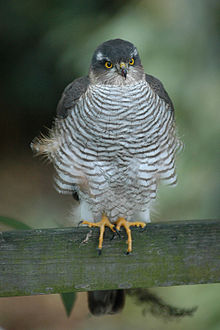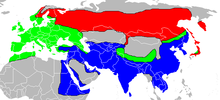Eurasian sparrowhawk
| Eurasian sparrowhawk | |
|---|---|
 |
|
| Male capturing common starling | |
 |
|
| Female | |
| Scientific classification | |
| Kingdom: | Animalia |
| Phylum: | Chordata |
| Class: | Aves |
| Order: | Accipitriformes |
| Family: | Accipitridae |
| Genus: | Accipiter |
| Species: | A. nisus |
| Binomial name | |
|
Accipiter nisus (Linnaeus, 1758) |
|
| Subspecies | |
|
A. n. granti |
|
 |
|
| Range of A. nisus Breeding summer visitor range Resident year-round range Non-breeding winter visitor range | |
A. n. granti
A. n. melaschistos
A. n. nisosimilis
A. n. nisus
A. n. punicus
A. n. wolterstorffi
The Eurasian sparrowhawk (Accipiter nisus), also known as the northern sparrowhawk or simply the sparrowhawk, is a small bird of prey in the family Accipitridae. Adult male Eurasian sparrowhawks have bluish grey upperparts and orange-barred underparts; females and juveniles are brown above with brown barring below. The female is up to 25% larger than the male – one of the largest differences between the sexes in any bird species. Though it is a predator which specialises in catching woodland birds, the Eurasian sparrowhawk can be found in any habitat and often hunts garden birds in towns and cities. Males tend to take smaller birds, including tits, finches, and sparrows; females catch primarily thrushes and starlings, but are capable of killing birds weighing 500 g (18 oz) or more.
The Eurasian sparrowhawk is found throughout the temperate and subtropical parts of the Old World; while birds from the northern parts of the range migrate south for winter, their southern counterparts remain resident or make dispersive movements. Eurasian sparrowhawks breed in suitable woodland of any type, with the nest, measuring up to 60 cm (2.0 ft) across, built using twigs in a tree. Four or five pale blue, brown-spotted eggs are laid; the success of the breeding attempt is dependent on the female maintaining a high weight while the male brings her food. The chicks hatch after 33 days and fledge after 24 to 28 days.
The probability of a juvenile surviving its first year is 34%, with 69% of adults surviving from one year to the next. Mortality in young males is greater than that of young females and the typical lifespan is four years. This species is now one of the most common birds of prey in Europe, although the population crashed after the Second World War. Organochlorine insecticides used to treat seeds before sowing built up in the bird population, and the concentrations in Eurasian sparrowhawks were enough to kill some outright and incapacitate others; affected birds laid eggs with fragile shells which broke during incubation. However, its population recovered after the chemicals were banned, and it is now relatively common, classified as being of Least Concern by BirdLife International.
...
Wikipedia

